Thermophiles in Love is a transmedia piece centering a 5-gender dating game that incorporates biological information about microorganisms into a playful critique of gender bio-essentialism. TiL has included a larp, a netprov, and an interactive gallery display. Its creators are Samara Hayley Steele, Mark Marino, Rob Wittig, and Cathy Podeszwa.
In this talk, Steele draws upon her experience working on Thermophiles in Love to discuss a game design methodology that she calls “gender playability,” through which gender is rendered a playable element of a game.

Game Design Methodologies for Gender Playability:
A Case Study of Thermophiles in Love
This talk was presented as part of the Social Studies of Live Action Role-Playing Games conference held at the European University of St. Petersburg on December 8th-9th, 2016.
Video of the talk may be viewed on youtube or facebook, and a full transcript may be found below.
My name is Samara Hayley Steele, and it is an honor to be here, albeit digitally, at the Social Studies of Live Action Role-Playing Games academic conference at the European University of St. Petersburg. Thank you very much for inviting me to speak. The name of my talk is “Game Design Methodologies for Gender Playability: A Case Study of Thermophiles in Love.”
Thermophiles in Love was a game I helped design, but before we talk about that, I first want to say a few words about what I mean when I talk about Gender Playability. Basically, I’m thinking about the way we render all sorts of things playable when we design larp. In a lot of larps, we render violence playable. And we do this in many ways: Nerf guns, boffer swords, rock paper scissors, dice even. We have all these elaborate rule sets that let us resolve what’s happening diegetically when we commit symbolic acts of violence in these ways we’ve designed. So we render, rather marvelously render, violence playable in larp. We render economy playable in larp. We render species playable—you can play an alien. We get to have this fantasy violence, fantasy economics, fantasy species, but what does it look like to have fantasy gender? And also, why is gender more difficult to render playable than any of these other world-building features?
This is a question I have been asking since 2005, when as part of a campaign larp in the American Pacific Northwest, I co-designed a sort of rule book addendum to allow a group of five-gendered elves to become part of that game. This was for a Tolkien-style game. That experience, which was greeted with mixed success in terms of gender playability, taught me a lot of things about designing for gender playability. One of the big takeaways, the biggest takeaway, from that experience being that gender is a two-way street: It isn’t enough to merely have a player perform a fantasy gender, that gender has to be recognized by your entire player-base for gender playability to be achieved. This means other players have to be primed and ready to interpret the behaviors of people playing a game gender through the filters of what they are supposed to assume about that game gender.
Thermophiles in Love is a larp I co-designed with Mark Marino, Rob Wittig, and Cathy Podeswa. It ran in conjunction with a netprov (a different medium) by the same name this fall, but the larp and the netprov were standalone pieces–you didn’t have to play one to play the other. I did a lot of work in parsing the initial gender system, which my collaborators brought some amazing contributions to and helped me modify and reduce (the genders were kind of rambling). We’ve done three runs of the larp so far. Mark and Rob and I did a beta-run of the game at the Berkeley Center for New Media at UC Berkeley in October, and then Mark and I did two official runs of the game as part of the gallery exhibit at the 2016 SLSA Conference in Atlanta.
Thermophiles in Love is [centered around] a five-gender dating game taking place in a microscopic society of extremophiles where everyone is looking to hook up with your special three someones, or “become part of the perfect quadrouple.” As I developed the initial gender schema for Thermophiles in Love, I asked how game design may be used to bypass the ideology of gender, and worked to construct gender playability at a more basic level of social materiality. To do this I drew heavily upon the work of cultural theorists, particularly the gender theory of Judith Butler (“foreclosures” and “performativity” were really key) and Michel Foucault’s “normalizing judgment,” as I attempted to construct conditions for Althusserian social apparatuses that I hoped would lead players to experience a sort of “reification moment” of their game gender.
The five genders were designed essentially as Barnum Statements, just like astrology signs, with rather broad but also specific identity statements, meaning a wide percentage of the population would be able to identify with specific features of the game gender they were assigned.

Our out-of-game gender assignment ritual included a large TV screen that had our Genderator cued up.
We had a little ‘X’ on the floor in front of it, so as people passed our display in the art gallery, Mark Marino and I would be there, sort of like salespeople, selling them gender—being all like, “Are you ready to learn your true gender?” “Let us gender you!” (LOL) And it was great! Some people were really digging it. Some people were terrified.
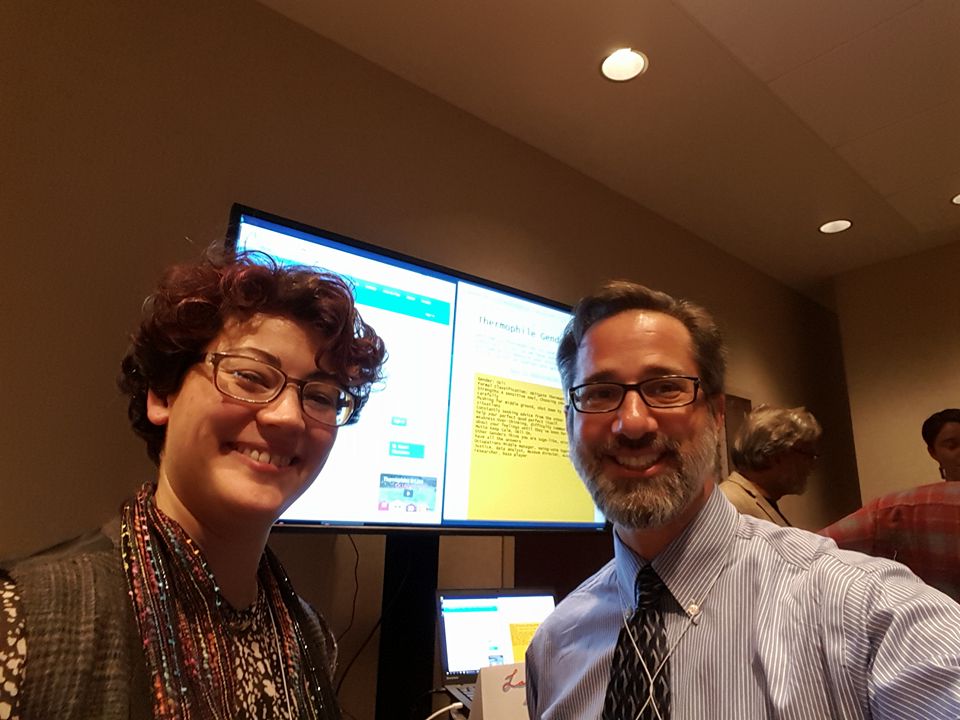
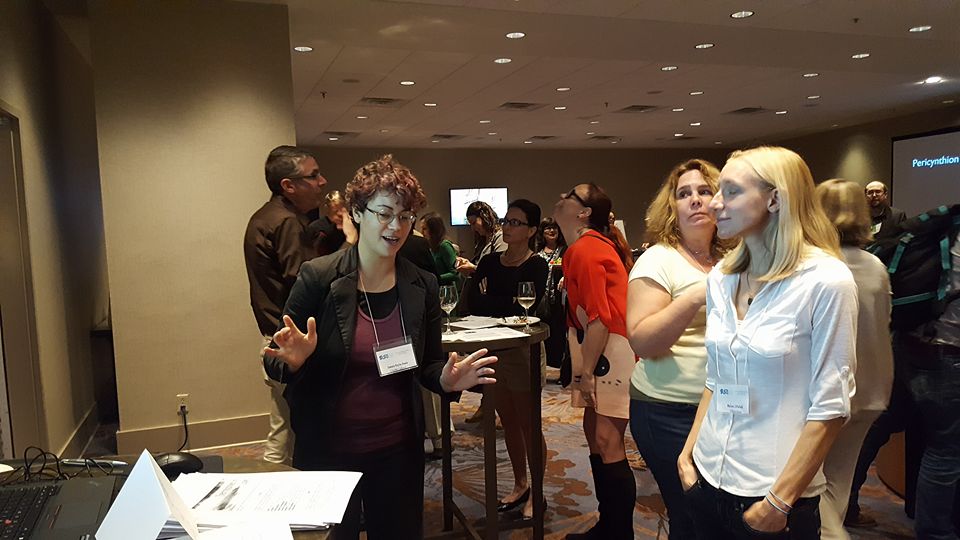

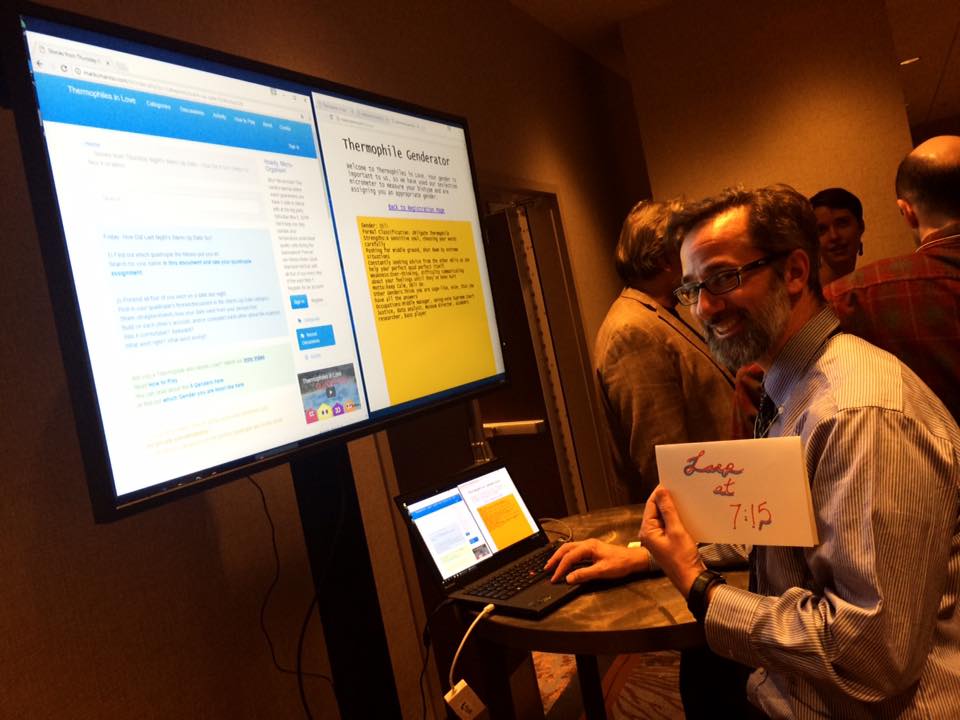
We’d have [the person] stand on the ‘X’ and hit a button and their gender would pop up, and at that point we’d give the person a packet with a description of all the genders, and we’d read their gender’s features aloud and invite them to join in for the five-gender dating game that would be happening later in the exhibit.
So that was a fun ritual for doing out-of-game gender assignment, and pulling people into what was very much a pop-up larp, in terms of the logistics of getting sign-ups for that game.
As I worked on the design for the system of genders, I researched non-binary and five-gendered societies from around the world, and I was inspired by some similarities I found in these gender paradigms which developed in total isolation from each other but had certain features. Based on this research, I designed a Gender of the Unconscious—the mesophiles, which were a matchmaker/shaman gender. This gender doesn’t take part in the dating—or at least in the romantic part of the dating—but they are there for the dates as observers, and ultimately they’re the ones who quadrouple people up. They make the decisions about who’s in a relationship with each other. That created a really interesting dynamic.

So, when the dating game starts, which is the core of the larp, what we did, what we do, is we have everyone stand in a circle and read all five gender profiles aloud, and we sort of prime them on normalizing judgment. We want to make sure that folks are calling each other out if they deviate. You want deviation to at least be recognized, whether it’s through shame or admiration, but you want people to catch it. Normalizing judgment is such a big part of what makes gender into a community dynamic, rather than something that’s simply going on in your head. Or, put another way, the social dynamic is a big part of what makes gender gender, and what makes gender playable.
Once we had everyone ready to normalize each other’s genders, we taught them gender dance moves that our dance coordinator Cathy Podeswa came up with. [These were] certain mannerisms that only your gender would make to help everyone remember who was what gender in this big group of people so they could keep reinforcing each other.

Another aspect of this was that we had people not being put into pairs but into quadruoples in this society. That’s the social norm there, you have four-person relationships. I really wanted this to be our relationship schema for a couple of reasons:
In terms of designing for gender playability, if you have two-person relationships, it’s just too easy to fall into out-of-game gender norms. I think this is a neurological thing, it has something to do with the way we make metaphors. When things are put into a pair, we start associating it with other groups of two like “above/below” “left/right” “big/small” and very soon you end up with a hierarchy, and the gender roles from the out-of-game world—from our culture at least—start to creep in.
So, having four-person relationships helped break that down, while also we wanted that [relationship schema] for safety reasons.
As experienced larpers know, romantic bleed is a thing, and having a game that’s designed to be played by a lot of first-time larpers who might not be ready for that, I figured 4-person relationships circumvent the romantic bleed aspect.
So [a 4-person relationship schema] becomes a way of solving a lot of problems (LOL), in terms of saying “What experiences do I want players to get out of this, verses what experiences am I not interested in them having to deal with.”
In terms of designing for gender playability, my most basic methodology is to start with the Althusserian social apparatuses and work my way backwards [towards them], thinking about what I’ve called Ideological Game Apparatuses and Repressive Game Apparatuses—I know Althusser called them “Ideological State Apparatuses” and “Repressive State Apparatuses,” but I’m using social apparatuses really differently than the state–it’s a consensual situation here–so I call them “game apparatuses.” But what I’m thinking about is “How are the norms of the [game] society reinforced ideologically in these fluid social-dynamic ways within the game?” And “How can I design towards also having them reinforced through social repression?” So I wrote mods* to this extent, for both of those approaches, and a majority of the [larpscript] is just written to explore different social apparatuses.
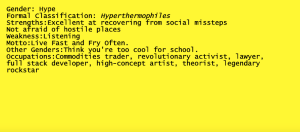
A really important factor of gender playability in design is deciding in what ways your game culture will construct fantasies of bio-essentialized gender, or if there even is bio-essentialized gender in your game world at all. For Thermophiles in Love, it was your preferred temperature range that led to you getting your gender assignment. There was a birth mod that we did to sort of clear up people’s ideas based on our out-of-game ideas of gender… As a designer for gender playability, you’re going to get questions backed in assumptions about how we assign gender in the out-of-game world, so while I was designing the game, a lot of questions kept coming up about copulation and reproduction because those things are a major part of the myth we use to assign gender roles in [out-of-game] society. My response to these questions was always, “Well, these are single-celled organisms we’re talking about for this game, so they reproduce through cell division, they actually reproduce alone without anyone else’s genetic material.” So at that point, a lot of people wanted to know, “Why have gender at all? If it you’re not reproducing [with the help of others]?” The answer of course is, “It’s a cultural thing.” Like in thermophile society, it would sound really weird to ask that because everyone knows you need to find your perfect quadrouple to achieve happiness. So I wrote a birth module that we ran in the third run of the game to help clear up some of those questions.
In the birth module, some folks experienced cell-division, so we had an extra person as an NPC stand behind the person who was about to experience cell division and then their quadrouple cheers them on and gives them emotional support as they go through the painful process of pulling their DNA apart to have cell division! And that was a way to say “Okay, we have these out-of-game rituals we use to assign gender, so how can I built them into the game in such a way that shows the way that thing is just different—that it’s not a factor in assigning gender in our [game] world here.”
The goal, ultimately, when you’re designing for gender playability, is for players to reify their game genders, which is to say, they take those social constructs to be facts of nature. It starts feeling “real.” Once that happens, you achieve a type of gender playability, a type of fluency in the things of the game gender. This I argue creates a more immersive alternative reality experience, because gender is something that so many of us take for granted in such a deep way, that achieving gender playability in a game creates this feeling of the surreal, like the sense of being in a truly different, truly foreign society, in a way that I think surpasses other forms of playability in game design. I believe gender playability shows us the amazing achievements of game design, in terms of what game design can teach us about our own culture.
So, looking at Thermophiles in Love: Did we achieve gender playability? My answer is “Yeah, sort of.” Some runs became more fluent in their game genders than others. It really depends on your player-base that day, and how motivated they feel to immerse themselves in a game that really, really goes beyond what most games render playable.
Running games in gender playability really reminds me of when Halo first came out, how confusing it was for players, for just a minute there, to get the hang of it. But once we did, suddenly we had this extra set of options—because, you know, you had a separate joystick to control your legs and torso with Halo, suddenly there was more flexibility, and for a minute, you’re like, “Waaa!” and then you figure it out. And I feel like with gender playability, it’s sort of like getting an extra set of options, an extra joystick, so you can create a more refined alternate reality gaming experience for players ready to take that step.
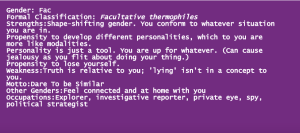
Overall, gender playability itself is a work in progress. It is a type of design that’s going to become more and more refined the more we, as a society, come to understand gender. So gender playability is reflexive, it grows with our ideas of gender, and it can help our ideas of gender grow. It’s a way to put gender theory into practice, and have a lot of fun doing it.
Finally, in terms of out-of-game applications. Millennials are the most gender variant and gender-defying generation we’ve seen in cultural memory, and the generation that’s coming next (the folks in high school and just starting college now) is even more gender-variant, with some studies showing that around 50% of the upcoming generation, at least in the United States, is identifying as something other then their assigned gender.
So, I see [gender playability] as something addressing a new social problem we’re starting to face as young people as we move out of the old gender paradigms. We have to start thinking about how we create new rituals of meaning to replace the ones we’re letting go of as we leave behind the old gender paradigms. I see gender playability as a way for social scientists to test their theories, and for folks to work towards building a more liberated society that still has meaningful rituals. Like we’ve got to figure out new ways to bring ourselves together in the [types of] ways old gender paradigms used to allow us. I see gender playability playing a big role in that work.
I have the full Thermophiles in Love larpscript up on my website at samarasteele.com. I invite any of you to give this game a try. You can play it in around 1.5 hours, and there are modules that let you stretch it out to become a full day’s experience. Likewise, feel free to email any questions about this talk or game to genderabolitionists[at]gmail[dot]com**.
Thank you very much for having me here, and I look forward to collaborating in the future!
*Mod – n. RPG jargon for “Adventure Module,” a prewritten interactive storyline that can be implemented as an optional feature in a larp.
**Note: Gender Abolitionism is not a movement to get rid of gender, but rather, simply, is a movement to resist non-consensual applications of gender.

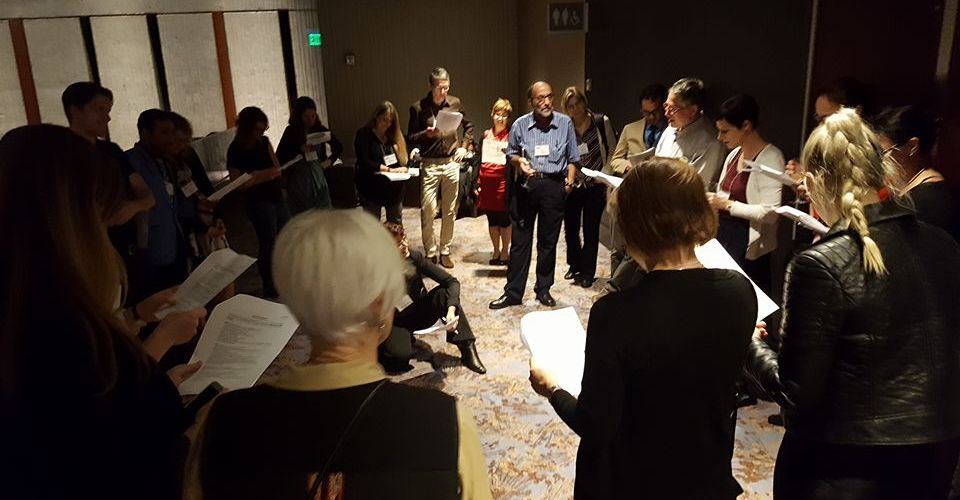
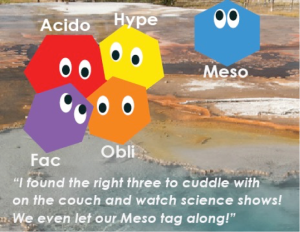
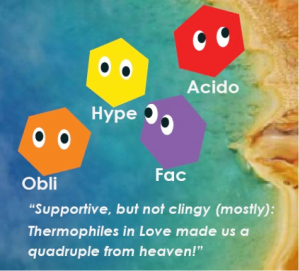
You must be logged in to post a comment.